Facile Detection and Quantification of Acetamiprid Using a Portable Raman Spectrometer Combined with Self-Assembled Gold Nanoparticle Array
Abstract
:1. Introduction
2. Experimental Section
2.1. Reagents and Instruments
2.2. Synthesis of Au NP Colloid
2.3. Preparation of Self-Assembled Au NP Array at the Interface of Water and Chloroform
2.4. SERS Detection of Acetamiprid
2.5. Real Sample Detection
3. Results and Discussion
3.1. Preparation of Self-Assembled Au NP Array at the Interface of Water and Chloroform
3.2. Comparison of Self-Assembled Au NP Array Based, Liquid Based, and Dried Liquid Droplet Based SERS Detection of Acetamiprid
3.3. Optimization of the Experimental Parameters
3.4. Specificity of the Developed Self-Assembled Au NP Array Based SERS Method
3.5. Detection of Acetamiprid by Self-Assembled Au NP Array Based SERS
3.6. Application of the Developed SERS Method in Quantitative Detection of Acetamiprid in Spinach and Apple
4. Conclusions
Supplementary Materials
Author Contributions
Funding
Institutional Review Board Statement
Informed Consent Statement
Data Availability Statement
Conflicts of Interest
References
- Weerathunge, P.; Ramanathan, R.; Shukla, R.; Sharma, T.K.; Bansal, V. Aptamer-controlled reversible inhibition of gold nanozyme activity for pesticide sensing. Anal. Chem. 2014, 86, 11937–11941. [Google Scholar] [CrossRef] [PubMed]
- Wijaya, W.; Pang, S.; Labuza, T.P.; He, L. Rapid Detection of Acetamiprid in Foods using Surface-Enhanced Raman Spectroscopy (SERS). J. Food Sci. 2014, 79, 1–5. [Google Scholar] [CrossRef] [PubMed]
- Kubackova, J.; Fabriciova, G.; Miskovsky, P.; Jancura, D.; Sanchez-Cortes, S. Sensitive surface-enhanced Raman spectroscopy (SERS) detection of organochlorine pesticides by alkyl dithiol-functionalized metal nanoparticles-induced plasmonic hot spots. Anal. Chem. 2015, 87, 663–669. [Google Scholar] [CrossRef] [PubMed]
- Renaud, M.; Akeju, T.; Natal-da-Luz, T.; Leston, S.; Rosa, J.; Ramos, F.; Sousa, J.P.; Azevedo-Pereira, H.M.V.S. Effects of the neonicotinoids acetamiprid and thiacloprid in their commercial formulations on soil fauna. Chemosphere 2018, 194, 85–93. [Google Scholar] [CrossRef] [PubMed]
- Cooper, R.L.; Laws, Ã.S.C.; Das, P.C.; Narotsky, M.G.; Goldman, J.M.; Tyrey, E.L.; Stoker, T.E. Atrazine and Reproductive Function: Mode and Mechanism of Action Studies. Birth Defects Res. Part B Dev. Reprod. Toxicol. 2007, 112, 98–112. [Google Scholar] [CrossRef]
- Tchounwou, P.B.; Wilson, B.A.; Ishaque, A.B.; Schneider, J. Atrazine potentiation of arsenic trioxide-induced cytotoxicity and gene expression in human liver carcinoma cells (HepG 2). In Molecular Mechanisms of Metal Toxicity and Carcinogenesis; Springer: Boston, MA, USA, 2001; pp. 49–59. [Google Scholar]
- Sanyal, D.; Chakma, D.; Alam, S. Persistence of a neonicotinoid insecticide, acetamiprid on chili (Capsicum annum L.). Bull. Environ. Contam. Toxicol. 2008, 81, 365–368. [Google Scholar] [CrossRef]
- Pramanik, S.K.; Bhattacharyya, J.; Dutta, S.; Dey, P.K.; Bhattacharyya, A. Persistence of acetamiprid in/on mustard (Brassica juncea L.). Bull. Environ. Contam. Toxicol. 2006, 76, 356–360. [Google Scholar] [CrossRef]
- Li, H.; Hu, W.; Hassan, M.M.; Zhang, Z.; Chen, Q. A facile and sensitive SERS-based biosensor for colormetric detection of acetamiprid in green tea based on unmodified gold nanoparticles. J. Food Meas. Charact. 2019, 13, 259–268. [Google Scholar] [CrossRef]
- Kwon, H.; Anastassiades, M.; Dörk, D.; Hong, S.M.; Moon, B.C. Compensation for matrix effects in GC analysis of pesticides by using cucumber extract. Anal. Bioanal. Chem. 2018, 410, 5481–5489. [Google Scholar] [CrossRef]
- Hussain, M.; Aftab, K.; Iqbal, M.; Ali, S.; Rizwan, M.; Alkahtani, S.; Abdel-Daim, M.M. Determination of Pesticide Residue in Brinjal Sample Using HPTLC and Developing a Cost-Effective Method Alternative to HPLC. J. Chem. 2020, 2020. [Google Scholar] [CrossRef]
- Lee, H.S.; Kim, S.W.; Abd El-Aty, A.M.; Chung, H.S.; Kabir, M.H.; Rahman, M.M.; Jeong, J.H.; Chang, B.J.; Shin, H.C.; Shim, J.H. Liquid chromatography–tandem mass spectrometry quantification of acetamiprid and thiacloprid residues in butterbur grown under regulated conditions. J. Chromatogr. B Anal. Technol. Biomed. Life Sci. 2017, 1055–1056, 172–177. [Google Scholar] [CrossRef]
- Han, C.Q.; Yao, Y.; Wang, W.; Tao, L.Q.; Zhang, W.X.; Ingram, W.M.; Tian, K.-z.; Liu, Y.; Lu, A.-x.; Wu, Y.; et al. Highly sensitive Silver Nanorod Arrays for Rapid Surface Enhanced Raman Scattering Detection of Acetamiprid Pesticides. Chinese J. Chem. Phys. 2018, 31, 152–158. [Google Scholar] [CrossRef]
- Zheng, J.; Pang, S.; Labuza, T.P.; He, L. Evaluation of surface-enhanced Raman scattering detection using a handheld and a bench-top Raman spectrometer: A comparative study. Talanta 2014, 129, 79–85. [Google Scholar] [CrossRef] [PubMed]
- Litti, L.; Trivini, S.; Ferraro, D.; Reguera, J. 3D Printed Microfluidic Device for Magnetic Trapping and SERS Quantitative Evaluation of Environmental and Biomedical Analytes. ACS Appl. Mater. Interfaces 2021, 13, 34752–34761. [Google Scholar] [CrossRef]
- Zhang, K.; Wang, Y.; Wu, M.; Liu, Y.; Shi, D.; Liu, B. On-demand quantitative SERS bioassays facilitated by surface-tethered ratiometric probes. Chem. Sci. 2018, 9, 8089–8093. [Google Scholar] [CrossRef] [PubMed] [Green Version]
- Zheng, J.; Pang, S.; Labuza, T.P.; He, L. Semi-quantification of surface-enhanced Raman scattering using a handheld Raman spectrometer: A feasibility study. Analyst 2013, 138, 7075–7078. [Google Scholar] [CrossRef]
- Cao, X.; Hong, S.; Jiang, Z.; She, Y.; Wang, S.; Zhang, C.; Li, H.; Jin, F.; Jin, M.; Wang, J. SERS-active metal-organic frameworks with embedded gold nanoparticles. Analyst 2017, 142, 2640–2647. [Google Scholar] [CrossRef]
- Sun, Y.; Li, Z.; Huang, X.; Zhang, D.; Zou, X.; Shi, J.; Zhai, X.; Jiang, C.; Wei, X.; Liu, T. A nitrile-mediated aptasensor for optical anti-interference detection of acetamiprid in apple juice by surface-enhanced Raman scattering. Biosens. Bioelectron. 2019, 145, 111672. [Google Scholar] [CrossRef]
- Su, M.; Wang, C.; Wang, T.; Jiang, Y.; Xu, Y.; Liu, H.; Liu, H.; Liu, H. Breaking the Affinity Limit with Dual-Phase-Accessible Hotspot for Ultrahigh Raman Scattering of Nonadsorptive Molecules. Anal. Chem. 2020, 92, 6941–6948. [Google Scholar] [CrossRef]
- Yu, F.; Su, M.; Tian, L.; Wang, H.; Liu, H. Organic Solvent as Internal Standards for Quantitative and High-Throughput Liquid Interfacial SERS Analysis in Complex Media. Anal. Chem. 2018, 90, 5232–5238. [Google Scholar] [CrossRef]
- He, L.; Chen, T.; Labuza, T.P. Recovery and quantitative detection of thiabendazole on apples using a surface swab capture method followed by surface-enhanced Raman spectroscopy. Food Chem. 2014, 148, 42–46. [Google Scholar] [CrossRef]
- Wang, P.; Sun, Y.; Li, X.; Shan, J.; Xu, Y.; Li, G. One-step chemical reaction triggered surface enhanced Raman scattering signal conversion strategy for highly sensitive detection of nitrite. Vib. Spectrosc. 2021, 113, 103221. [Google Scholar] [CrossRef]
- Khlebtsov, N.G. Determination of size and concentration of gold nanoparticles from extinction spectra. Anal. Chem. 2008, 80, 6620–6625. [Google Scholar] [CrossRef] [PubMed]
- Xu, Y.; Konrad, M.P.; Lee, W.W.Y.; Ye, Z.; Bell, S.E.J. A Method for Promoting Assembly of Metallic and Nonmetallic Nanoparticles into Interfacial Monolayer Films. Nano Lett. 2016, 16, 5255–5260. [Google Scholar] [CrossRef] [PubMed] [Green Version]
- Liang, Y.; Hilal, N.; Langston, P.; Starov, V. Interaction forces between colloidal particles in liquid: Theory and experiment. Adv. Colloid Interface Sci. 2007, 134–135, 151–166. [Google Scholar] [CrossRef] [PubMed]
- Liu, J.W.; Zhang, S.Y.; Qi, H.; Wen, W.C.; Yu, S.H. A general strategy for self-assembly of nanosized building blocks on liquid/liquid interfaces. Small 2012, 8, 2412–2420. [Google Scholar] [CrossRef] [PubMed]
- Wang, K.; Sun, D.W.; Pu, H.; Wei, Q. Two-dimensional Au@Ag nanodot array for sensing dual-fungicides in fruit juices with surface-enhanced Raman spectroscopy technique. Food Chem. 2020, 310, 125923. [Google Scholar] [CrossRef]
- Wei, W.; Huang, Q. Preparation of cellophane-based substrate and its SERS performance on the detection of CV and acetamiprid. Spectrochim. Acta-Part A Mol. Biomol. Spectrosc. 2018, 193, 8–13. [Google Scholar] [CrossRef]
- Di Muccio, A.; Fidente, P.; Barbini, D.A.; Dommarco, R.; Seccia, S.; Morrica, P. Application of solid-phase extraction and liquid chromatography-mass spectrometry to the determination of neonicotinoid pesticide residues in fruit and vegetables. J. Chromatogr. A 2006, 1108, 1–6. [Google Scholar] [CrossRef]
- Jin, D.; Xu, Q.; Yu, L.; Mao, A.; Hu, X. A novel sensor for the detection of acetamiprid in vegetables based on its photocatalytic degradation compound. Food Chem. 2016, 194, 959–965. [Google Scholar] [CrossRef]
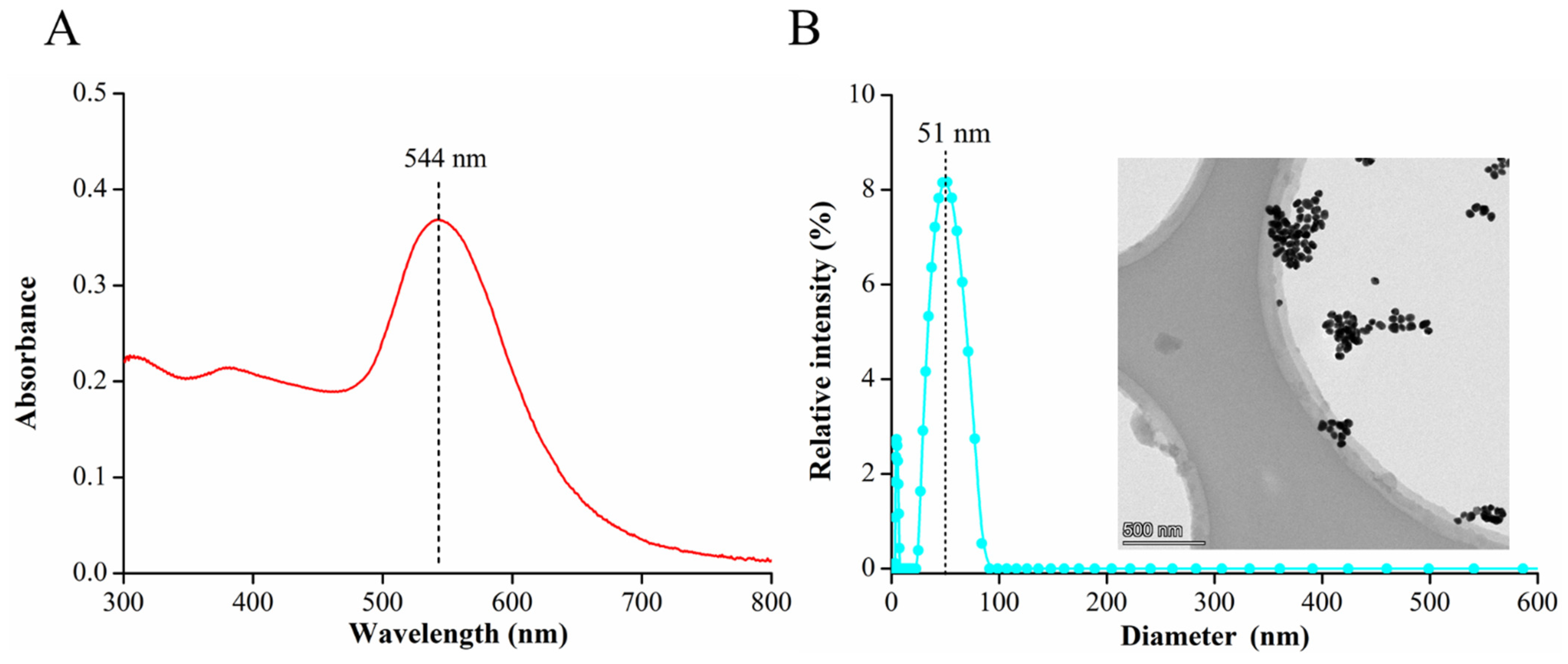
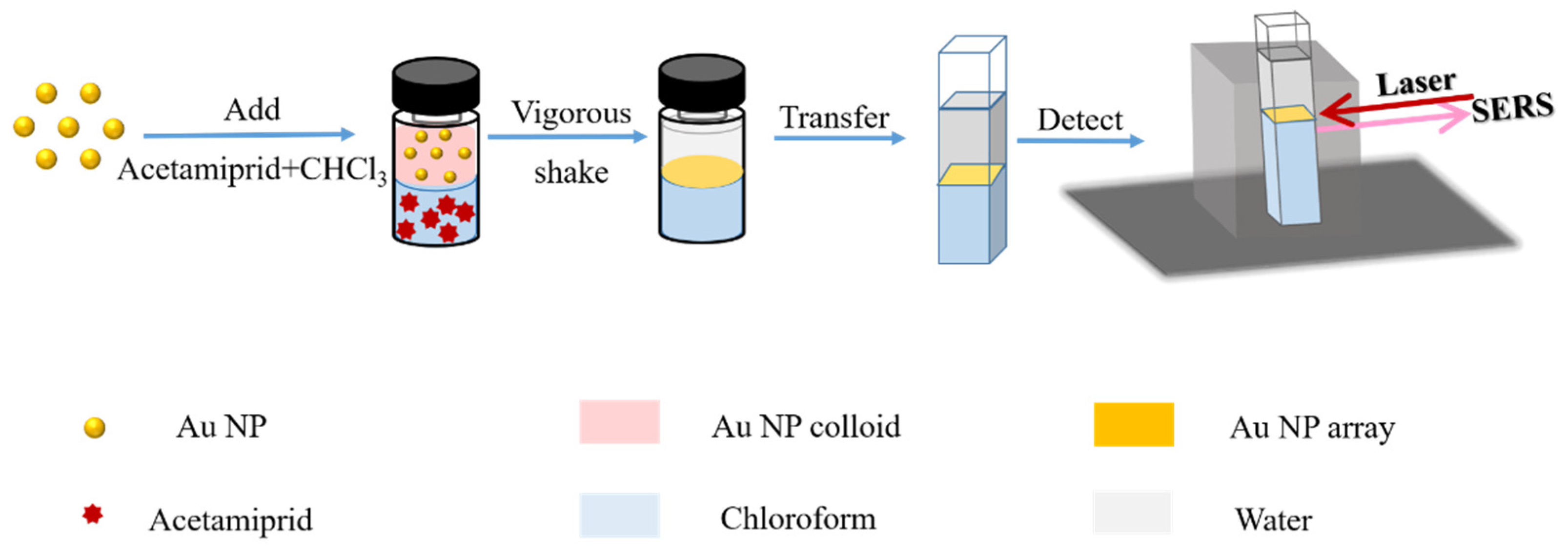

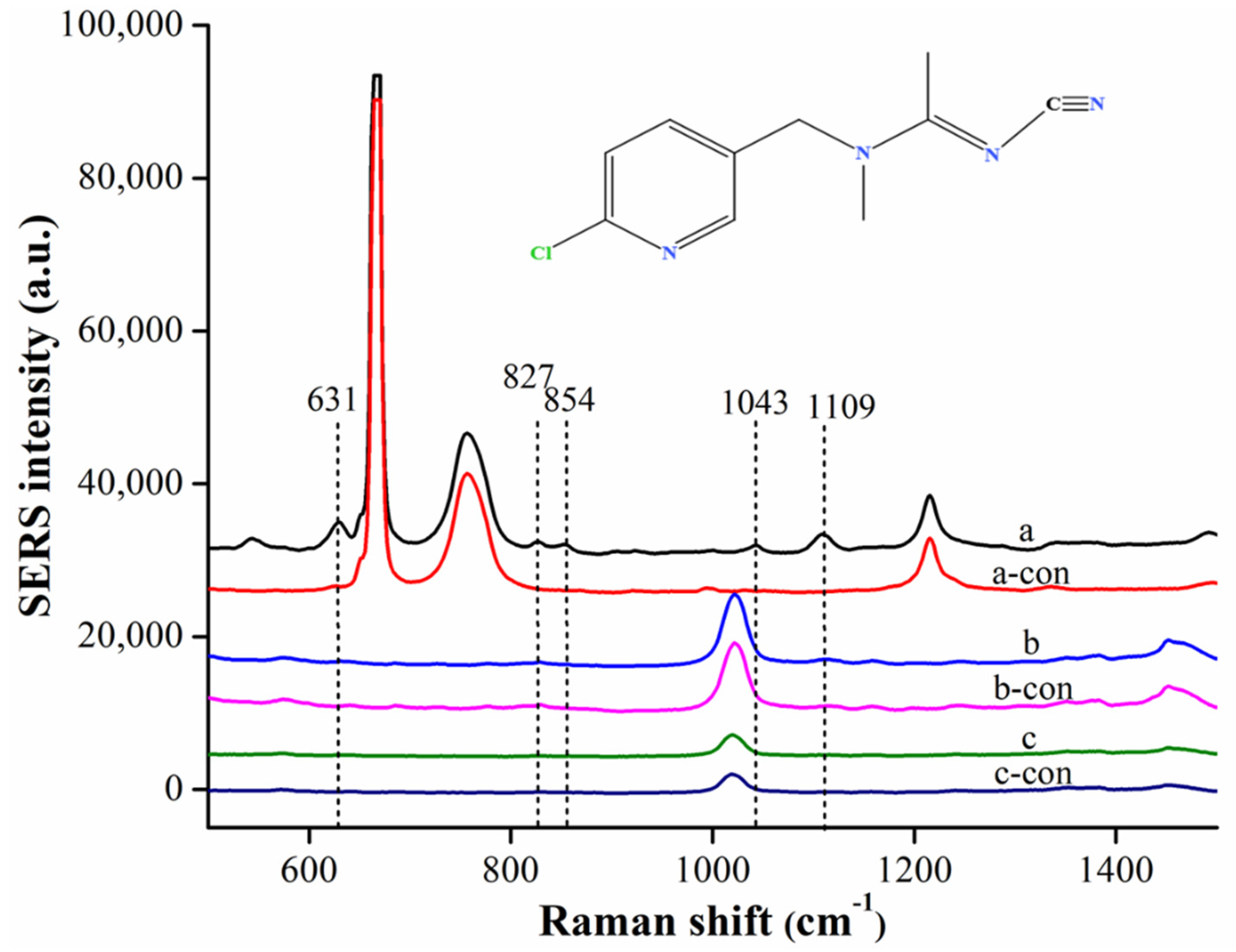
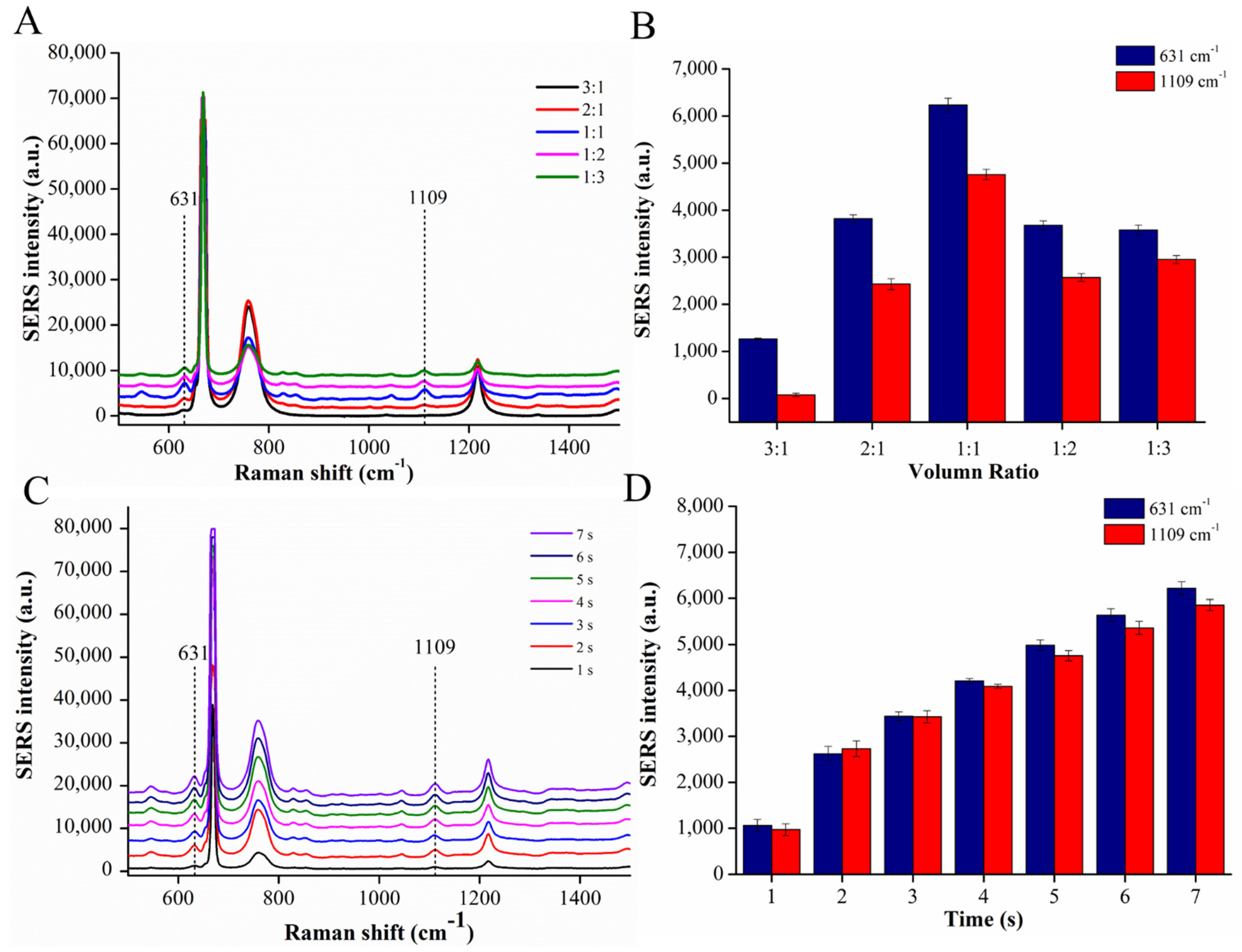
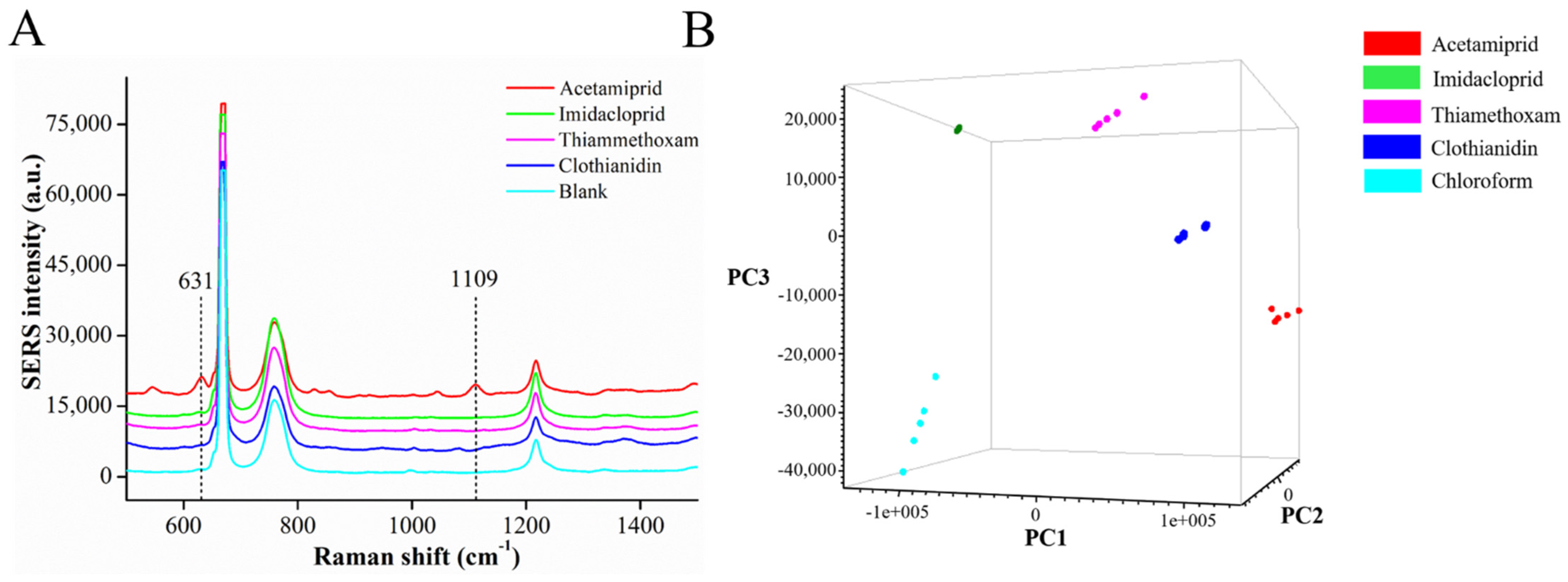
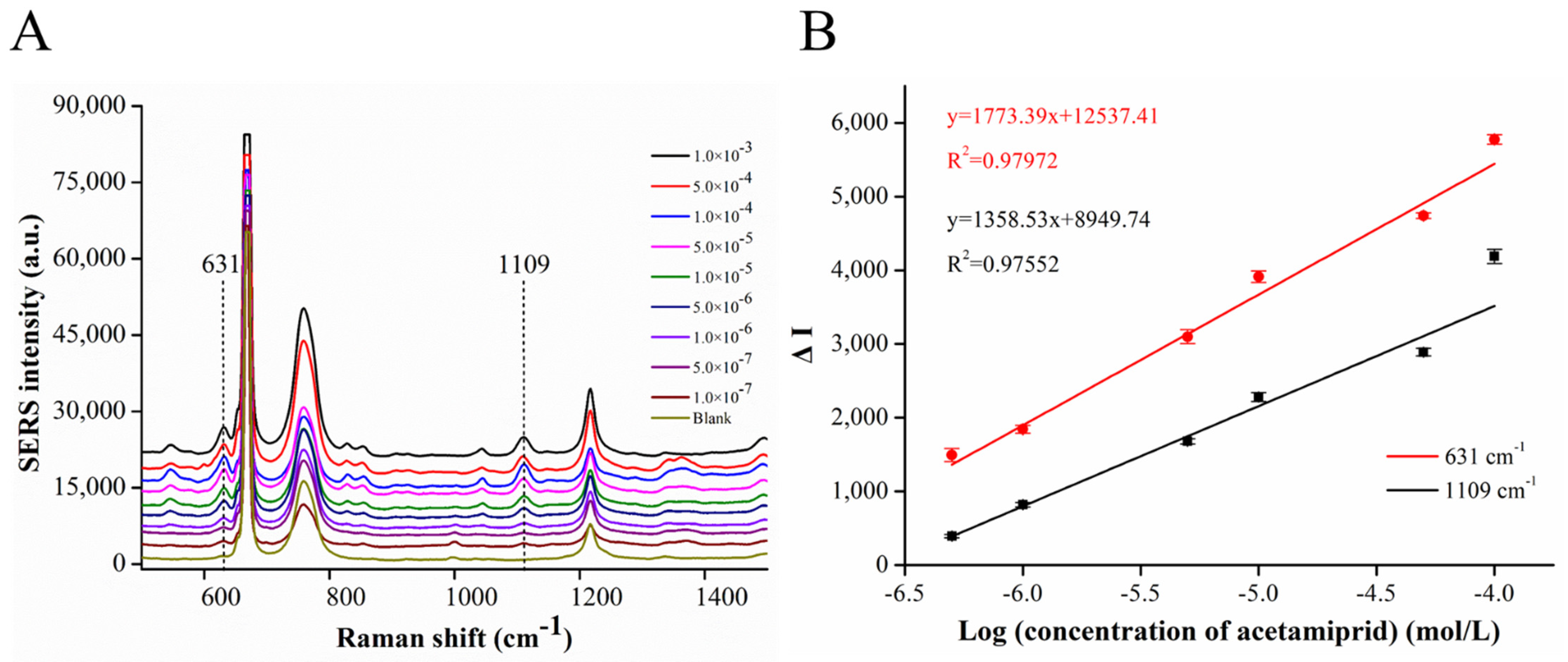
| Analytical Method | Liner Range | LOD | LOQ | R2 | References |
|---|---|---|---|---|---|
| LC-MS/MS | 1.802 × 10−8 to 1.802 × 10−6 mol/kg | 2.7 × 10−9 mol/kg | 8.98 × 10−9 mol/kg | 0.9998 | [12] |
| SPE/LC–MS | 2.2 × 10−7 to 2.2 × 10−6 mol/L | 9.0 × 10−8 mol/L | - | - | [30] |
| Colorimetry | 1 × 10−7 to 1 × 10−5 mol/L | 1.0 × 10−7 mol/L | - | - | [1] |
| Electrochemistry | 1.0 × 10−8 to 2.0 × 10−6 mol/L | 2.0 × 10−10 mol/L | - | 0.998 | [31] |
| SERS | 4.5 × 10−6 to 4.5 × 10−4 mol/L | 4.5 × 10−6 mol/L | - | - | [29] |
| SERS | 5.0 × 10−7 to 1.0 × 10−4 mol/L | 1.19 × 10−7 mol/L | 2.63 × 10−7 mol/L | 0.97972 | This work |
| Samples | Spiked Concentration (mol/L) | Detected Concentration (mol/L) | Recovery (%) | ||
|---|---|---|---|---|---|
| 631 cm−1 | 1109 cm−1 | 631 cm−1 | 1109 cm−1 | ||
| Spinach | - | - | - | - | - |
| 1.0 × 10−6 | 8.259 × 10−7 | 7.369 × 10−7 | 82.59 | 73.69 | |
| 1.0 × 10−5 | 8.759 × 10−6 | 9.755 × 10−6 | 87.59 | 97.55 | |
| Apple | - | - | - | - | - |
| 1.0 × 10−6 | 8.617 × 10−7 | 9.807 × 10−7 | 86.17 | 98.07 | |
| 1.0 × 10−5 | 9.701 × 10−6 | 9.706 × 10−6 | 97.01 | 97.06 | |
Publisher’s Note: MDPI stays neutral with regard to jurisdictional claims in published maps and institutional affiliations. |
© 2021 by the authors. Licensee MDPI, Basel, Switzerland. This article is an open access article distributed under the terms and conditions of the Creative Commons Attribution (CC BY) license (https://creativecommons.org/licenses/by/4.0/).
Share and Cite
Wang, P.; Sun, Y.; Wang, L.; Li, X.; Liu, M.; Li, G. Facile Detection and Quantification of Acetamiprid Using a Portable Raman Spectrometer Combined with Self-Assembled Gold Nanoparticle Array. Chemosensors 2021, 9, 327. https://doi.org/10.3390/chemosensors9110327
Wang P, Sun Y, Wang L, Li X, Liu M, Li G. Facile Detection and Quantification of Acetamiprid Using a Portable Raman Spectrometer Combined with Self-Assembled Gold Nanoparticle Array. Chemosensors. 2021; 9(11):327. https://doi.org/10.3390/chemosensors9110327
Chicago/Turabian StyleWang, Panxue, Yan Sun, Li Wang, Xiang Li, Miaomiao Liu, and Guoliang Li. 2021. "Facile Detection and Quantification of Acetamiprid Using a Portable Raman Spectrometer Combined with Self-Assembled Gold Nanoparticle Array" Chemosensors 9, no. 11: 327. https://doi.org/10.3390/chemosensors9110327
APA StyleWang, P., Sun, Y., Wang, L., Li, X., Liu, M., & Li, G. (2021). Facile Detection and Quantification of Acetamiprid Using a Portable Raman Spectrometer Combined with Self-Assembled Gold Nanoparticle Array. Chemosensors, 9(11), 327. https://doi.org/10.3390/chemosensors9110327







